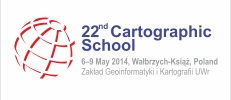Cartographic School 2014 on Geoinformatics and Atmospheric Science
Contributed by Tomasz Niedzielski
 Recent advances in climatology and meteorology are associated with progress in geoinformatics, a discipline that combines numerous computer-based techniques for processing, analyzing and modeling spatial data.
Recent advances in climatology and meteorology are associated with progress in geoinformatics, a discipline that combines numerous computer-based techniques for processing, analyzing and modeling spatial data.
For the last decade, atmospheric scientists have been utilizing such tools to carry our both fundamental and applied research on weather-related problems. Nowadays, geographic information systems, remote sensing as well as physical and empirical modeling should be perceived as standard methods which climatologists and meteorologists use in their investigations.
The objective of the forthcoming 22nd Cartographic School 2014 on ‘Geoinformatics and Atmospheric Science‘, to be held in Wałbrzych-Książ in Poland on 6-9 May 2014, is to bring together new ideas and leading experts in the fields of geoinformatics and broadly understood atmospheric science.
It is believed that a conference in the picturesque Książ Castle will strengthen the discussion between the two groups, leading to a better understanding and cooperation.
The conference language is English.
Abstract Deadline: 5th of February 2014
The detailed information on the conference is available here. It will focus on the following six topics, which also correspond to oral sessions:
- Data-based modelling of atmospheric processes
- Physically-based modelling of atmospheric processes
- Visualization of climatologic and meteorological data
- Geospatial climatologic analyses and their use in other scientific disciplines
- Climatological maps, atlases and web services
- Sources of spatial data in climatology
Associated with the forthcoming 22nd Cartographic School 2014 is a special issue of Pure and Applied Geophysics on ‘Geoinformatics and Atmospheric Science’. Authors of oral or poster presentations will be invited to submit their manuscript to the aforementioned special issue. However, the publication may only be offered to such papers that will successfully go through a strict peer-review process, typical for the JCR journals. The manuscripts which do not fit the PAGEOPH profile can be submitted to another journal, namely Geodesy and Cartography. Obviously, such manuscripts will have to go through a strict peer-review process too.
For more info, visit the website at: http://www.cartoschool.uni.wroc.pl/
0 comments